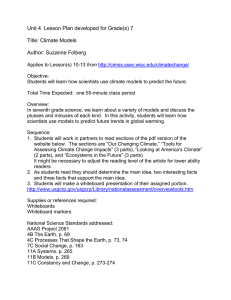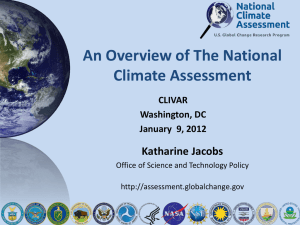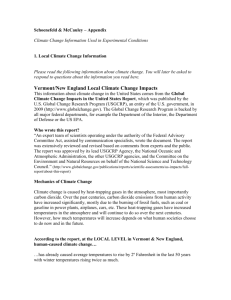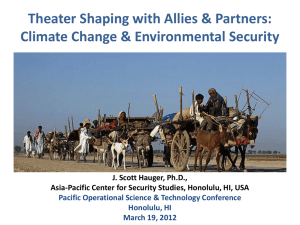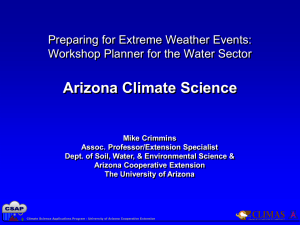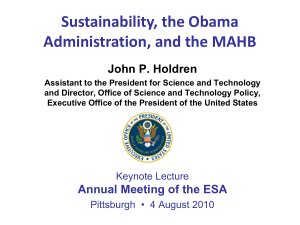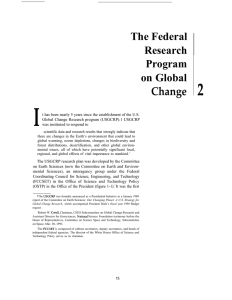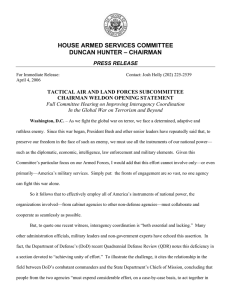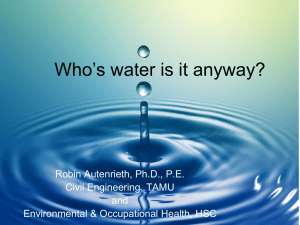A REPORT BRIEF IN
advertisement
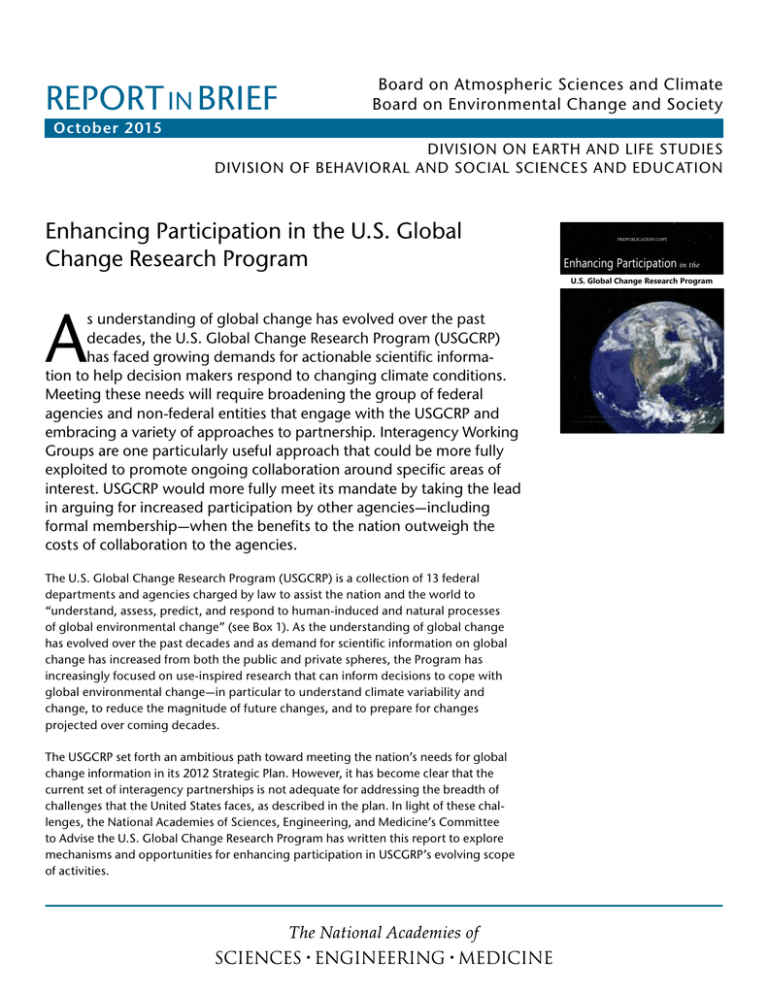
REPORT IN BRIEF Board on Atmospheric Sciences and Climate Board on Environmental Change and Society October 2015 DIVISION ON EARTH AND LIFE STUDIES DIVISION OF BEHAVIOR AL AND SOCIAL SCIENCES AND EDUCATION Enhancing Participation in the U.S. Global Change Research Program PREPUBLICATION COPY Enhancing Participation in the U.S. Global Change Research Program A s understanding of global change has evolved over the past decades, the U.S. Global Change Research Program (USGCRP) has faced growing demands for actionable scientific information to help decision makers respond to changing climate conditions. Meeting these needs will require broadening the group of federal agencies and non-federal entities that engage with the USGCRP and embracing a variety of approaches to partnership. Interagency Working Groups are one particularly useful approach that could be more fully exploited to promote ongoing collaboration around specific areas of interest. USGCRP would more fully meet its mandate by taking the lead in arguing for increased participation by other agencies—including formal membership—when the benefits to the nation outweigh the costs of collaboration to the agencies. The U.S. Global Change Research Program (USGCRP) is a collection of 13 federal ­departments and agencies charged by law to assist the nation and the world to ­“understand, assess, predict, and respond to human-induced and natural processes of global environmental change” (see Box 1). As the understanding of global change has evolved over the past decades and as demand for scientific information on global change has increased from both the public and private spheres, the Program has increasingly focused on use-inspired research that can inform decisions to cope with global environmental change—in particular to understand climate variability and change, to reduce the magnitude of future changes, and to prepare for changes projected over coming decades. The USGCRP set forth an ambitious path toward meeting the nation’s needs for global change information in its 2012 Strategic Plan. However, it has become clear that the current set of interagency partnerships is not adequate for addressing the breadth of challenges that the United States faces, as described in the plan. In light of these challenges, the National Academies of Sciences, Engineering, and Medicine’s Committee to Advise the U.S. Global Change Research Program has written this report to explore mechanisms and opportunities for enhancing participation in USCGRP’s evolving scope of activities. Box 1. The U.S. Global Change Research Program The U.S. Global Change Research Program (USGCRP) was established by the U.S. Global Change Research Act of 1990. The Act charged the Program to coordinate research on “changes in the global environment (including alterations in climate, land productivity, oceans or other water resources, atmospheric chemistry, and ecological systems) that may alter the capacity of the Earth to sustain life.” Research activities include “study, monitoring, assessment, prediction, and information management activities to describe and understand” these sorts of changes. Today, 13 federal departments and agencies are formal members of USGCRP: • Department of Transportation (DOT) • Department of Agriculture (USDA) • Department of Commerce (DOC) • Environmental Protection Agency (EPA) • Department of Defense (DOD) • National Aeronautics and Space Administration (NASA) • Department of Energy (DOE) • National Science Foundation (NSF) • Department of Health and Human Services (HHS) • Smithsonian Institution (SI) • Department of the Interior (DOI) • U.S. Agency for International Development (USAID) • Department of State (DOS) MISMATCH BETWEEN USGCRP GOALS AND PARTICIPATION Through the 1990s, the main emphasis of the USGCRP was on enhancing the underlying scientific foundation for understanding global environmental change. This emphasis was reflected in large investments in observing programs and process-based research on the physical aspects of the climate system, as well as the emphasis on Earth system science as a framework for computational models of environmental change. Box 2. The USGCRP Strategic Plan USGCRP’s most recent Strategic Plan was published in 2012 and lays out a vision for the Program that maintains a clear emphasis on advancing global change science, but also calls for a strengthened focus on informing real-world decisions and actions. There are four strategic goals for the Program: 1. Advance Science — Advance scientific knowledge of the integrated natural and human components of the Earth system to understand climate and global change. 2. Inform Decisions — Provide the scientific basis to inform and enable timely decisions on adaptation and mitigation. 3. Conduct Sustained Assessments — Build sustained assessment capacity that improves the Nation’s ability to understand, anticipate, and respond to global change impacts and vulnerabilities. 4. Communicate and Educate — Advance communication and education to broaden public understanding of global change. However, as the Program has matured, there has been an important shift in the relative balance of its goals and objectives. Advances in global change research have demonstrated the importance of human actions in shaping the future of the planet and have presented options for managing the consequences of those actions. Moreover, as the impacts of climate change become more apparent, decision makers in both the public and private spheres are increasingly looking to science for guidance about policies, actions, and funding. Reflecting these changing needs, the USGCRP’s most recent Strategic Plan, published in 2012 (see Box 2), includes research meant to aid problem solving, as well as research intended to increase fundamental understanding of the processes of global environmental change. To achieve the goals and objectives in the Strategic Plan, the Program requires integration of the perspectives of other agencies and parts of agencies with which it has not previously had strong engagement, as well as entities outside the federal government, particularly those responsible for making decisions related to global change. This might include state and local governments, international programs and foreign governments, business and community groups, professional societies, mass media entities, educational institutions, and other non-governmental entities engaged in making or informing global change decisions. Conclusion 1: USGCRP needs broader partnerships and participation from within existing member agencies and from new entities to achieve its goals. EMPLOYING SEVERAL MODES OF PARTICIPATION As USGCRP looks to expand the number and types of partners with which it engages, it will also need to broaden the sorts of partnerships it employs. The mode of collaboration will need to be tailored to address the specific tasks or objectives at hand. Furthermore, the types of partnerships will continue to evolve as the challenges of global change, particularly climate change, increase. Different modes of partnership may be appropriate to reach different goals in the strategic plan. For example, in pursuit of Goal 1 (Advancing Science), collaboration might take the form of coordinated research programs, and perhaps partnering agencies might eventually become full USGCRP members. In contrast, reaching Goal 2 (Informing Decisions) requires processes that link analysis to deliberation to ensure that there is communication between scientists and decision makers about what is known and what needs to be known. Collaboration designed to address specific tasks can foster informal ties and habits of cooperation with networks of actors that can help create a more agile and responsive government. For example, the most recent National Climate Assessment demonstrated that having a tangible task helps promote collaboration across multiple agencies and entities at the Federal, state, and local levels and with the users of the assessments. Conclusion 2: USGCRP could most effectively achieve its goals by embracing a variety of approaches to partnership. UTILIZING INTERAGENCY WORKING GROUPS TO ADDRESS SPECIFIC TASKS AND ENGAGE NETWORKS OF ACTORS Interagency Working Groups can promote enhanced participation by bringing together multiple federal agencies to coordinate efforts on specific tasks. The USGCRP can create and disband interagency working groups as they are needed or as they fulfill their appointed tasks, making them a useful mechanism for different agencies to interact with a minimum of administrative overhead. The town of Hannibal, MO, was inundated by flood waters stemming from the Mississippi River in 2008. Source: Jocelyn Augustino/FEMA Figure 2. Specific topics — such as the impacts of global change on urban environments or the impacts of extreme events — showcase opportunities where resources of federal agencies can be brought to bear on the decisions being made at regional or local levels on an ongoing basis. Urban areas are particularly vulnerable to extreme events, given their locations (often on coasts or rivers), high concentration of people, and complex, interdependent, and aging infrastructure. USGCRP could work to better connect federal resources with regional centers already working to support climaterelated decisions or take steps to stimulate new public-private collaborations that can connect appropriate federal expertise to decision makers at the city level. Several Interagency Working Groups have successfully coordinated efforts across multiple agencies, effectively incorporating contributions from non-member agencies and pointing to the potential value of these types of activities. For example, the Adaptation Working Group and the Climate Change and Human Health Working Group were very active in the most recent National Climate Assessment. Areas like the linking of data sets to better understand impacts Figure 1. One key area where federal agencies of global change or the support of miticould work together to support decisions is in gation decisions could be explored as reductions of greenhouse gas emissions (i.e., opportunities for new working groups. mitigation). Agencies at all levels of government — from federal to state and city or local authorities — face many choices in the selection and design of regulatory actions, subsidy programs, and public investments to address mitigate emissions in their jurisdictions. These agencies need credible, objective, and sciencebased means to assess options and measure progress. USGCRP could help coordinate relevant data collection, research efforts, and technical support activities of agencies — such as the Department of Housing and Urban Development, the United States Department of Agriculture, and the Department of Transportation — that support decisions related to ­mitigation. Interagency Working Groups also provide a mechanism for USGCRP to engage the networks of actors with which participating agencies already work. For example, activities related to informing decisions will involve scientific products developed by the agencies, but, depending on the decisions in question, may also involve regional-, state-, and local-level governmental agencies, tribal and territorial governments, sector-based owners and managers (e.g., banking and finance, energy and infrastructure), and organizations that connect various actors. Conclusion 3: The Interagency Working Groups are one particularly useful approach that could be more fully exploited as a means to promote ongoing collaboration around specific areas of interest and creating networks of partners. CONSIDERING THE FULL COSTS AND BENEFITS OF PARTICIPATION Whatever form it may take, participation in USGCRP activities comes with real costs. Participants devote staff time to supporting core USGCRP activities, such as coordinating meetings and analyzing how programs are addressing priorities for global change research. At the federal level, these costs are almost exclusively borne by the agencies themselves. At the same time, participation in USGCRP activities also comes with benefits. Member agencies gain support for their research programs, are able to use the results of USGCRP science to support their missions, and increase the audience for their research. In some cases, broader participation that incorporates several different bureaus within an agency could help that agency focus its efforts and better meet its own mission. By and large though, the benefits of increased participation in USGCRP activities will be to the nation as a whole. Decision makers across multiple sectors of the economy and at multiple levels of government can benefit from improved global change information. The overall costs and benefits should be weighed carefully, at a national level, to determine if enhanced collaboration is appropriate and how to apportion the costs of partnership. Not all agencies need participate at the same level. Employing a range of approaches for interaction could broaden the Program’s focus and engage new partners, without the need for formal participation. More transitory research challenges may only require a temporary collaboration, for example through an Interagency Working Group. Decisions about formal membership are likely to be guided by multiple considerations in addition to roles in funding research. While the Committee believes that the USGCRP itself should have the responsibility for making the case for including new agencies or parts of agencies, the final decision will more appropriately be made above the Program’s level, presumably within the OSTP. Conclusion 4: USGCRP would more fully meet its mandate by taking the lead in arguing for increased participation by other agencies—including formal membership—when the benefits to the nation outweigh the costs of collaboration to the agencies. Locate information on related reports at http://dels.nas.edu/basc Download (free) or purchase this report at www.nap.edu Committee to Advise the U.S. Global Change Research Program: Warren Washington (Chair), National Center for Atmospheric Research, Boulder, CO; Kai Lee (Vice Chair), The David and Lucile Packard Foundation (retired ), Los Altos, CA; Mark Abbott, Oregon State University, Corvallis; Doug Arent, National Renewable Energy Laboratory, Golden, CO; Susan Avery, Woods Hole Oceanographic Institute, MA; Arrietta Chakos, Urban Resilience Strategies, Berkeley, CA; Peter Daszak, EcoHealth Alliance, New York, NY; Thomas Dietz, Michigan State University, East Lansing; Kristie L. Ebi, University of Washington, Seattle; Baruch Fischhoff, Carnegie Mellon University, Pittsburgh, PA; Nancy B. Grimm, Arizona State University, Tempe; Henry Jacoby, Massachusetts Institute of Technology, Cambridge; Anthony C. Janetos, Boston University, MA; Haroon S. Kheshgi, ExxonMobil Research and Engineering Company, Annandale, NJ; Richard H. Moss, University of Maryland, College Park; Ian Noble, ND-GAIN, Vienna, VA; Margo Oge, U.S. Environmental Protection Agency (retired ), MacLean, VA; Kathleen Segerson, University of Connecticut, Storrs; Kathleen Tierney, University of Colorado, Boulder; Charles J. Vorosmarty, City University of New York, NY; Edward Dunlea (Senior Program Officer, Board on Atmospheric Sciences and Climate), Paul Stern (Senior Scholar, Board on Environmental Change and Society), Amanda Purcell (Research and Financial Associate, BASC ), Rita Gaskins (Administrative Coordinator, BASC ), National Academies of Science, Engineering, and Medicine The National Academies appointed the above committee of experts to address the specific task requested by the U.S. Global Change Research Program. The members volunteered their time for this activity; their report is peer-reviewed and the final product signed off by both the committee members and the National Academies. This report brief was prepared by the National Research Council based on the committee’s report. For more information, contact the Board on Atmospheric Sciences and Climates at (202) 334-3512 or visit http://dels.nas.edu/basc. Copies of Enhancing Participation in the U.S. Global Change Research Program are available from the National Academies Press, 500 Fifth Street, NW, Washington, D.C. 20001; (800) 624-6242; or as free PDFs at www.nap.edu. Permission granted to reproduce this brief in its entirety with no additions or alterations. Permission for images/figures must be obtained from their original source. © 2015 The National Academy of Sciences
